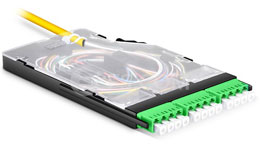
Patch Panel
Typically, a patch panel is used to terminate all the field fibers onto connectors which can then be patched with an optical patch cable to one of several pieces of active equipment. For instance, you could offer a shared port GPON service, a point to point 1 Gbps service or even a very high speed 10 Gbps point to point link. Depending on what the customer wanted, you would just patch that customer to the appropriate equipment port.
Some ISPs get by with no patch panels at all. The Michaelston-y-Fedw network is only serving 200 customers, and so they opted to simply splice in 12 port pigtail patch cables directly onto their field fiber cables and plug directly into their equipment.
A fiber patch panel will typically start with a cassette. A cassette will have twelve fiber connectors respectively attached to 12 loose fibers. You simply fusion splice one of the field cable buffer tubes (12 fibers) onto the cassette's loose fibers. The cassettes then slide into a shelf which is then attached to a rack. You can terminate up to 6,048 fibers onto connectors on one six foot high 42U rack this way using equipment from FS.com, but there are other racking and patching companies as well.
You can also get racking systems which have built in splitters if you are doing a GPON central office split. Clearfield is one company that makes fiber patch panels with integrated splitters.

